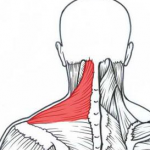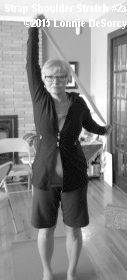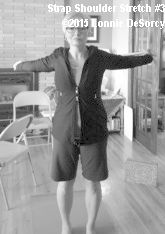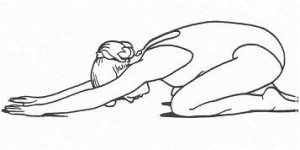 Shoulders often carry heavy loads. They mark the juncture of our torsos with our upper limbs. When the postural muscles in our torsos are weak or tight, our shoulders, which are a relatively unstable joint, often compensate. And we use our upper limbs to carry out innumerable tasks – lifting, carrying, reaching, washing, driving, raking, riding, typing, gardening, writing and so on. All of these require a certain amount of stability AND mobility in the shoulder joints. Probably worst of all, we find ourselves stuck in a stationary position, often sitting at a desk, for long periods of time. We lose the ordinary range of motion in our shoulders. The image to the left highlights the upper trapezius – a muscle that often locks long – that often performs its work in a stretched position, putting itself and many other structures at risk in the process.
Shoulders often carry heavy loads. They mark the juncture of our torsos with our upper limbs. When the postural muscles in our torsos are weak or tight, our shoulders, which are a relatively unstable joint, often compensate. And we use our upper limbs to carry out innumerable tasks – lifting, carrying, reaching, washing, driving, raking, riding, typing, gardening, writing and so on. All of these require a certain amount of stability AND mobility in the shoulder joints. Probably worst of all, we find ourselves stuck in a stationary position, often sitting at a desk, for long periods of time. We lose the ordinary range of motion in our shoulders. The image to the left highlights the upper trapezius – a muscle that often locks long – that often performs its work in a stretched position, putting itself and many other structures at risk in the process.
Shoulder flexion, extension, abduction, adduction, internal rotation and external rotation comprise the expected movements of the shoulder girdle. Guidelines exist for what we should be able to anticipate with respect to our shoulder mobility, but many of us discover that our bodies fail regarding some or all of these.
Here, I offer a simple series with a strap to maintain and perhaps improve shoulder range of motion. Note that this series of stretches may not be appropriate if you suffer from dysfunction of the scapula (your shoulder blade mobility / stability balance (another topic altogether) is not entirely functional). Likewise, conditions with the elbows, wrists or hands may preclude use of this series. Those with heart conditions will want to exercise caution with holding arms over the head for long periods – you may want to practice some of these movements while laying on the floor. Regardless, you are urged to be deeply aware of sensations in your shoulders and elsewhere while performing this or any other activity and use calm and prudent judgement when determining whether it is appropriate for you.
If, in your practice you are particularly concerned about treating or avoiding a shoulder, elbow, wrist or hand injury (as opposed to managing mood, healing from trauma, or caring for chronic pain for example), you likely will want to practice with an alignment-based focus. To align, stand with the feet evenly placed facing forward with weight balanced front-to-back and side-to-side. Ensure that the knees face forward and are stacked above the ankles. Level the pelvis (again, front-to-back and side-to-side) and place it directly above the knees. Lengthen the torso, with symmetrical tone in front and back, chest and upper back evenly broad and shoulder girdle and blades gently depressed directly above pelvis. Level the head. Throughout the suggested movements gently restrain the lower front ribs from jutting forward, keep the head level, elbows extended, and wrists erect. Reaching from the inner elbows, forearms and wrists to the knuckle at the base of each thumb likely will help in this respect. Maintain a still quietness in the rest of the body as the arms and shoulders make the movements.
1.Stand in tadasana or mountain pose with the hands holding a strap, long towel, or discarded man’s tie with a wide grip (about 30°) out to either side down in front of the legs. Only you will be able to determine how far apart is wide enough. Generally, the wider, the “easier.” Feel free to adjust the grip on the strap at any time throughout the movements, but know that the exercise is meant to be done with a taut strap. Maintain a “longer, softer, smoother” breath throughout.
 2. Gradually start to take the strap in front and upward, noticing sensations in the arms, neck, shoulders and torso as you do.
2. Gradually start to take the strap in front and upward, noticing sensations in the arms, neck, shoulders and torso as you do.
You may want to cycle with awareness up and down in front of you a few times, synchronizing the movement with your breath and paying attention to what you feel in your hands, arms and shoulders.
 3. When it’s time to move on, take one arm down to the side while bringing the other up by your ear, noticing the movement of each shoulder blades as you do.
3. When it’s time to move on, take one arm down to the side while bringing the other up by your ear, noticing the movement of each shoulder blades as you do.
Bring the arms through the upright position before taking them to the other side.
Gently and with awareness, cycle through the three positions while synchronizing with the breath.
 4. If and when the shoulders and arms desire a deeper movement, hold the upper arm erect and stabilize the lower shoulder by drawing the shoulder blade down and in. Slightly externally rotate the upper part of the lowest arm and take the arm back and down. A wider grip on the strap may be necessary for safety or comfort.
4. If and when the shoulders and arms desire a deeper movement, hold the upper arm erect and stabilize the lower shoulder by drawing the shoulder blade down and in. Slightly externally rotate the upper part of the lowest arm and take the arm back and down. A wider grip on the strap may be necessary for safety or comfort.
Feel into the hands, wrists, arms, shoulders, neck, and upper torso. Ensure the breath is flowing naturally.
Return to the upright arms position and repeat with awareness to the other side.
As desired, cycle through the positions explored so far with strong focus on sensation and breath. Calmly back off a little if the experience feels risky or too intense.
 5. Another interesting movement is to take the strap behind the back, both hands at the same time. Often the strap needs to be held with a slightly wider grip to complete this movement.
5. Another interesting movement is to take the strap behind the back, both hands at the same time. Often the strap needs to be held with a slightly wider grip to complete this movement.
Focus on what you feel in wrists, elbows, shoulders and shoulder blades, and if possible, the upper trunk. Notice the natural flow of your breath.
You may want to cycle up and down gently for awhile with the breath.
Regarding alignment, if that’s your focus, the chin and ribs are likely to jut forward so the head should be kept level and upper core stability recruited. Further, the elbows may feel undue strain; caution should be exercised.
 6. You might want to continue taking the arms all the way down behind you. Continue to attend to sensations in hands, arms, and shoulder. You may have noticed that the nature and intensity of feeling-tone changes with every degree of movement.
6. You might want to continue taking the arms all the way down behind you. Continue to attend to sensations in hands, arms, and shoulder. You may have noticed that the nature and intensity of feeling-tone changes with every degree of movement.
Regarding alignment, you may have seen in the images above and to the left that the arms are not moving at the same pace. Not a big deal, but a yoga therapist might find that of note in working with me!
My wrists also are not erect. Again, this is not of particular importance but I may be over-developing some muscles at the expense of others and this alignment may cause an injury (acute or chronic) at some point.
If the movements have proceeded to this point without difficulty, I suggest you play with moving through all the positions in a flow, maintaining a “longer, softer, smoother” breath as you do. I like to practice this with straight arms, erect wrists, still head and torso, and taut strap so that I know the movement is coming from my shoulders.
Enjoy playing with this series, and marvel in the mobility, sensation and awareness that are yours!








